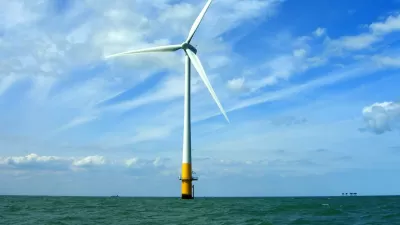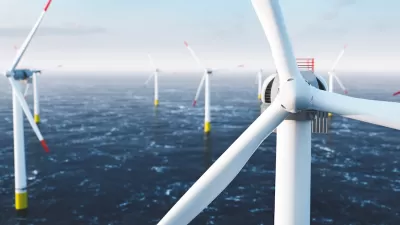The Port of Humboldt has proposed a plan to modernize its facilities to accommodate offshore wind energy production, hoping to stimulate the local economy and create sustainable jobs.

While the East Coast has moved forward with testing and building out offshore wind energy infrastructure, California has lagged due to the Pacific's deep waters and local political challenges. Now, with the Biden administration pushing for more investment in offshore wind and Governor Newsom signing a bill calling for a statewide offshore wind plan, Emma Foehringer Merchant reports that boosters of Northern California's Port of Humboldt are hoping to attract federal investment for what could be a lucrative industry.
While the port has many characteristics that make it a promising location for a wind energy hub, a federal contract will still require the construction of additional facilities to accommodate production, assembly, and transportation of turbines and associated equipment. To achieve this, the Humboldt Bay Harbor, Recreation and Conservation District has developed a two-phase plan to renovate the port into a modern terminal capable of supporting wind infrastructure. "Most essential to the plan is a 'heavy-lift terminal,' basically a huge dock that can support the weight and size of different wind turbine components, including blades longer than a football field and towers nearly as tall as the Washington Monument."
Meanwhile, environmentalists express concerns about how wind turbines may affect local marine life and the environment, while other locals worry about the costs of yet another extractive industry in a region formerly ruled by lumber mills. Local officials express optimism that the industry will bring sustainable jobs and a clean source of energy to the region.
FULL STORY: As the Biden Administration Eyes Wind Leases Off California’s Coast, the Port of Humboldt Sees Opportunity

Maui's Vacation Rental Debate Turns Ugly
Verbal attacks, misinformation campaigns and fistfights plague a high-stakes debate to convert thousands of vacation rentals into long-term housing.

Planetizen Federal Action Tracker
A weekly monitor of how Trump’s orders and actions are impacting planners and planning in America.

San Francisco Suspends Traffic Calming Amidst Record Deaths
Citing “a challenging fiscal landscape,” the city will cease the program on the heels of 42 traffic deaths, including 24 pedestrians.

Defunct Pittsburgh Power Plant to Become Residential Tower
A decommissioned steam heat plant will be redeveloped into almost 100 affordable housing units.

Trump Prompts Restructuring of Transportation Research Board in “Unprecedented Overreach”
The TRB has eliminated more than half of its committees including those focused on climate, equity, and cities.

Amtrak Rolls Out New Orleans to Alabama “Mardi Gras” Train
The new service will operate morning and evening departures between Mobile and New Orleans.
Urban Design for Planners 1: Software Tools
This six-course series explores essential urban design concepts using open source software and equips planners with the tools they need to participate fully in the urban design process.
Planning for Universal Design
Learn the tools for implementing Universal Design in planning regulations.
Heyer Gruel & Associates PA
JM Goldson LLC
Custer County Colorado
City of Camden Redevelopment Agency
City of Astoria
Transportation Research & Education Center (TREC) at Portland State University
Jefferson Parish Government
Camden Redevelopment Agency
City of Claremont





























